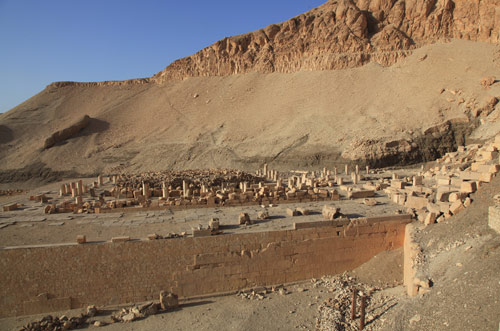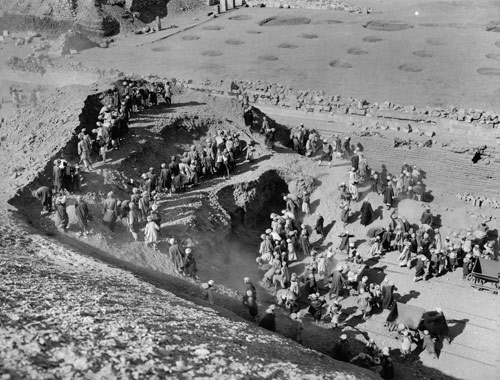 Traveling Exhibitions
Traveling Exhibitions Traveling Works of Art
Traveling Works of Art Conservation Projects
Conservation Projects Excavations
Excavations Fellows
Fellows Exchanges & Collaborations
Exchanges & Collaborations Multiple Items
Multiple Items
The Met Around the World presents the Met’s work via the global scope of its collection and as it extends across the nation and the world through a variety of domestic and international initiatives and programs, including exhibitions, excavations, fellowships, professional exchanges, conservation projects, and traveling works of art.
The Met Around the World is designed and maintained by the Office of the Director.
Traveling
Exhibitions
The Met organizes large and small exhibitions that travel beyond the Museum's walls, extending our scholarship to institutions across the world. See our national and international traveling exhibition program from 2009 to the present.
Traveling
Works of Art
The Met lends works of art to exhibitions and institutions worldwide to expose its collection to the broadest possible audience. See our current national and international loans program.
Conservation
Projects
The preservation of works of art is a fundamental part of the Met's mission. Our work in this area includes treating works of art from other collections. See our national and international conservation activities from 2009 to the present.
Excavations
The Met has conducted excavations for over 100 years in direct partnership with source countries at some of the most important archaeological sites in the world. Today we continue this tradition in order to gain greater understanding of our ancient collections. See our national and international excavation program from the Met's founding to the present.
Fellows
The Met hosts students, scholars, and museum professionals so that they can learn from our staff and pursue independent research in the context of the Met's exceptional resources and facilities. See the activities of our current national and international fellows.
Exchanges & Collaborations
The Met's work takes many forms, from participation in exchange programs at partnering institutions and worldwide symposia to advising on a range of museum issues. These activities contribute to our commitment to advancing the work of the larger, global community of art museums. See our national and international exchange program and other collaborations from 2009 to the present.
 Temple of Mentuhotep II Nebhepetre at Deir el-Bahri. Photograph by Dieter Arnold, 2010.
Temple of Mentuhotep II Nebhepetre at Deir el-Bahri. Photograph by Dieter Arnold, 2010. Work in progress at the temple of Mentuhotep II Nebhepetre: layout of the temple tree grove is visible in the background. Photograph by Harry Burton, 1921–22 (M3C 136). Archives of the Egyptian Expedition, Department of Egyptian Art.
Work in progress at the temple of Mentuhotep II Nebhepetre: layout of the temple tree grove is visible in the background. Photograph by Harry Burton, 1921–22 (M3C 136). Archives of the Egyptian Expedition, Department of Egyptian Art. Tomb shafts of the princesses Myt and Aashyt on the platform of the temple of Mentuhotep II Nebhepetre. Photograph by Harry Burton, 1920–21 (MCC 12). Archives of the Egyptian Expedition, Department of Egyptian Art.
Tomb shafts of the princesses Myt and Aashyt on the platform of the temple of Mentuhotep II Nebhepetre. Photograph by Harry Burton, 1920–21 (MCC 12). Archives of the Egyptian Expedition, Department of Egyptian Art.
Jewelry of the Child Myt
Middle Kingdom, Dynasty 11, early reign of Mentuhotep II, ca. 2051–2030 B.C.
Egypt, Upper Egypt; Thebes, Deir el-Bahri, Tomb of Myt, Temple of Nebhepetre Mentuhotep, Pit 18, mummy of Myt, MMA 1921
Rogers Fund and Edward S. Harkness Gift, 1922 (22.3.320-24)

Egypt
1920–1931
The monument was first excavated in 1903 to 1907 by Edouard Naville for the British Egypt Exploration Fund. In 1910, the area of the temple complex became an essential part of the concession of the Metropolitan Museum. When Metropolitan Museum Egyptologist Herbert E. Winlock began his exploration of the temple in 1920, only some specific and more meticulous projects were left to be carried out. Nevertheless, during five field seasons (ending in 1931), important discoveries were made, such as the tomb shafts of the two Dynasty 11 princesses Myt and Aashyt; the foundation deposits under the temple platform; and the ancient tree grove in front of the temple.
Important objects from the burials of the princesses, together with examples of the architecture and decoration of the temple, are now on display in the Museum's Egyptian galleries 104 and 105. They include one of the sandstone statues of the king, found in the area of the temple grove. Winlock's work in the temple did not lead to a final documentation of the monument. But his studies of the temple and of the Dynasty 11 cemeteries surrounding it produced, besides many other achievements, his 1947 publication The Rise and Fall of the Middle Kingdom in Thebes, a relatively small book that became an eye-opener for a whole generation of Egyptologists who, for the first time, discovered the importance of Thebes for the study of the Middle Kingdom, a major phase of Egyptian culture. Since then, more work has been carried out on the temple, but it has not yet been restored and is not open to visitors.

